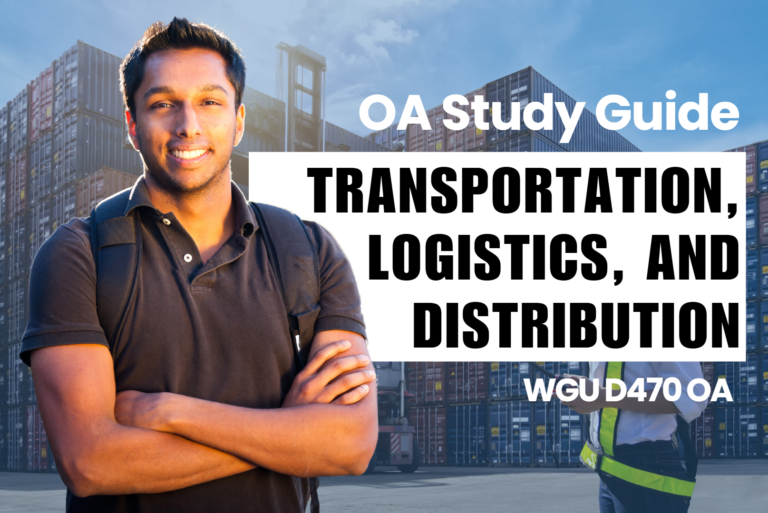WGU C233 OA Study Guide - 2025 | Navigating the Complexities of Employment Law📖
You have arrived at the unpredictable realm of Employment Law. Wondering about employer firing freedom or employee classification standards should drive you to read further. This article examines three fundamental WGU C233 subjects that explain employment law processes with their vital workplace applications.
This article explores three key concepts in employment law that impact workplace rights, worker classifications, and job security:
- Union Practices and Employee Rights: Labor unions play a crucial role in advocating for employee rights, including fair wages, benefits, and working conditions. Understanding union practices and laws like the National Labor Relations Act (NLRA) helps employees and employers navigate collective bargaining and workplace protections.
- Independent Contractor vs. Employee: Using the Economic Realities Test: The classification of workers as employees or independent contractors affects their rights, benefits, and tax obligations. The Economic Realities Test assesses factors like control, financial dependence, and work conditions to determine the correct classification.
- Employment-At-Will and Its Exceptions: In the U.S., employment-at-will allows employers to terminate employees at any time without cause. However, there are exceptions, including public policy violations, implied contracts, and good faith dealings, which protect workers from wrongful termination.
These concepts will get a clear explanation without pushing any complex legal language into the text. Your knowledge regarding employment law will be ready to ace WGU C233 OA questions when you complete this material. Let’s get started!
How to Use This Guide for the WGU C233 OA Exam?📖
The C233 Employment Law OA exam at WGU evaluates your understanding of labor law, worker classifications, and employee rights. This guide simplifies the key concepts of union practices and employee rights, independent contractor vs. employee (using the Economic Realities Test), and employment-at-will and its exceptions to help you grasp the topics tested in the exam.
We also provide exam-style questions and practical applications to ensure you’re fully prepared for the questions on the WGU C233 OA exam.

Union Practices and Employee Rights For C233 OA📝
Employees depend on union organizations for the protection of their rights which also guarantees equal treatment in workplace settings. This part will outline union operation methods alongside the protected worker rights and the legal framework that controls union practices. Knowledge of these concepts draws you closer to success on WGU C233 OA assessments and related questions.
Key Laws and Regulations
Several laws impact union practices and employees’ rights:
- National Labor Relations Act (NLRA): This act grants employees the right to form unions, bargain collectively, and strike.
- Labor Management Relations Act (LMRA): Known as the Taft-Hartley Act, it limits union power and protects employers from unfair union practices.
- Labor Management Reporting and Disclosure Act (LMRDA): This law ensures unions operate transparently and that leaders are accountable to their members.
Union Activities and Employee Rights
Unions significantly impact employees’ rights in the following ways:
- Forming Unions: Employees have the right to form unions and advocate for their interests. This is the first step toward improving workplace conditions.
- Collective Bargaining: Unions negotiate with employers to improve wages, benefits, and working conditions for their members.
- Strikes: If negotiations fail, unions can organize strikes to push employers toward an agreement.
- Employer Rights: Organizations expect their workforce to be punctual and dedicated and to support the organizational achievements. On the other hand, these work expectations cannot restrict employee rights to unionize or fight for their professional interests.
How Union Practices Impact Employee Rights
Union practices help protect and promote employee rights:
- Collective Bargaining: Through collective bargaining, unions secure higher wages, better benefits, and improved working conditions for workers. This reduces disparities between job positions.
- Workplace Safety: Unions take action to protect workplace safety by establishing measures that help keep employees safe at their worksites. Safety equipment along with reporting tools and health insurance coverage fall under the protection provided by unions.
- Protection Against Unfair Practices: Unions safeguard workers from unfair labor practices, ensuring they can report grievances without fear of retaliation.
- Job Security: Unionized workers generally enjoy more job security. Employers find it more challenging to lay off or terminate union workers without just cause.
Potential Restrictions and Obligations of Union Membership
While union membership offers many benefits, it also comes with certain restrictions:
- Union Security Agreements: Under the NLRA, unions and employers may agree that employees must join the union or pay dues within a certain period after being hired.
- Duty of Fair Representation: Unions must fairly represent all members, even when individual interests conflict with the group’s needs.
- Loss of Individual Bargaining Power: After joining a union members waive their personal autonomy for employment negotiations to rely on collective union negotiations.
- Penalties for Non-compliance: Employees who fail to pay union dues or break union rules may face fines or even termination.
Ensuring Fair Treatment for All Employees
Unions help ensure that all employees are treated fairly in the workplace:
- Collective Bargaining: By negotiating on behalf of workers, unions standardize wages and benefits, reducing pay gaps between workers in similar positions.
- Workplace Safety: Trade unions develop better workplace safety standards which allow workers to protect themselves while enabling them to disclose hazards without employer intimidation.
- Protection from Unfair Practices: Unions act as a safeguard against unfair treatment, ensuring workers can voice concerns and push for changes in the workplace.
- Fair Representation: Even employees who object to full union membership can benefit from union representation. They may choose to remain “core” members and pay only for services directly related to collective bargaining.
- Transparency: Unions must disclose any potential conflicts of interest in the bargaining process to ensure that employees are fully informed and that the negotiations are fair.
Employer Interference and Union Protection For C233 OA
The right to join a union as well as form new associations stands protected under law from employer interference. Organizations receive criminal penalties when they threaten workers with dismissal because they join unions and when they take action against employees who engage in union activities. Unions must respect employee freedom to refuse union membership while employers cannot prevent employees from exercising their union rights. Workers must have unrestricted freedom to organize their groups.
The distinction between an independent contractor and an employee becomes essential for WGU C233 students while determining worker classification through Economic Realities Test analysis.
Independent Contractor vs. Employee: Using the Economic Realities Test For C233 OA📝
Employers need to use the Economic Realities Test to establish if workers qualify as independent contractors or employees during classification decisions. Through this examination, organizations learn whether workers depend financially on their business operations or operate independent business activities. Employee rights derived from labor laws remain protected because they differ from independent contractor entitlements.
What is the Economic Realities Test?
The Economic Realities Test provides specific criteria for determining whether FLSA regulations apply to a worker through its guidelines. A worker either depend on the employer for their economic needs or maintain their entrepreneurial independence to qualify as employee or independent contractor respectively. The Department of Labor implements the test as its principal assessment instrument to categorize workers according to several specified elements.
Tax and legal status determine that workers who depend on their employers must be treated as employees while obtaining employee rights to overtime pay and minimum wage standards. The absence of employee benefits makes proper classification essential when determining worker independence as an independent contractor.
The Six Factors of the Economic Realities Test
The Department of Labor applies six elements to evaluate worker dependence on their employer against their self-business status. These factors are considered together in the totality of circumstances, and no single factor is weighted more heavily than others:
- Opportunity for Profit or Loss
Workers who can influence their income by negotiating pay or taking on more work are typically independent contractors. If a worker’s pay is more predictable and controlled by the employer, they are more likely an employee. - Investments by the Worker and the Employer
Independent contractors invest company resources to expand their business operations by buying equipment as well as promoting their professional services. The typical worker does not invest in such equipment as employers usually cover all required tools and resources. - Degree of Permanence of the Work Relationship
Buildings with a group of independent contractors maintain time-limited employment arrangements centered around specific projects. Employees generally maintain sustained continuous business relationships with their employer. - Nature and Degree of Control
When an employer maintains authority over scheduling as well as working methods and implementation methods this indicates employee status. The working conditions for independent contractors usually grant them independent control over workspace methods alongside flexibility in scheduling and work location. - Extent to Which the Work is Integral to the Employer’s Business
If the work is central to the business’s operations, it points toward the worker being an employee. Independent contractors typically work on tasks outside the core operations of the business. - Skill and Initiative
Independent contractors often use specialized skills and show initiative to grow their businesses. Employees typically follow set procedures and use less business-oriented initiatives.
Key Differences Between Independent Contractors and Employees
Now that we’ve covered the factors of the Economic Realities Test, let’s look at the key differences between independent contractors and employees:
- Independence and Control
As independent contractors, you gain independence through decisions about your working times and methods of undertaking work assignments. Working under company policies and direct employer control defines the employee’s role. - Relationship with the Company
Independent contractors typically work for multiple clients on a project-by-project basis, whereas employees usually work for one employer long-term. - Flexibility
Independent contractors can choose when and how much to work, while employees are expected to dedicate their work hours to one employer. - Financial Aspects
Employees receive a regular paycheck with taxes withheld. Independent contractors are paid per project and handle their own taxes, including self-employment taxes. - Benefits
Workers access three main workplace benefits which include paid rest time together with medical coverage and retirement packages. Independence contractors need to manage their medical benefits on their own. - Tools and Equipment
Employees typically use tools and equipment provided by their employer, while independent contractors supply their own tools for the job. - Legal Protections
Employees are protected by employment laws, including minimum wage and overtime pay. Independent contractors do not receive these protections.
Why Misclassification Matters
Employers face legal consequences when they misclassify workers because this mistake results in back-pay claims while generating tax penalties and requiring payment of fines. Misclassification may force employers to pay benefits that the employees did not receive including scheduled overtime work and workers’ compensation coverage. Businesses need to properly use the Economic Realities Test to avoid misclassification mistakes with their workers.
The knowledge of the Economic Realities Test and employee–independent contractor determination enables employers to stay out of legal trouble while fulfilling employment law requirements. A proper determination of employee versus independent contractor status matters since it affects how you will handle workplace relationships.
Before diving into Employment-At-Will and its exceptions, it’s important to understand how employment relationships are structured, as this doctrine plays a pivotal role in WGU C233 employment law.
Tired of reading blog articles?
Let’s Watch Our Free WGU C233 Practice Questions Video Below!

Employment-At-Will and Its Exceptions For C233 OA 📖
Workers at most work locations join the employment-at-will doctrine framework. Employers possess the freedom to terminate employee relationships whenever they want as long as they bypass illegal reasons unless contracts oppose this right. An employee holds the right to depart their position whenever they want with no legal penalties. Employers alongside their employees receive substantial independence through this arrangement.
Employers have the power to dismiss employees from certain roles without needing specific causes unless the dismissal violates Montana labor laws prohibiting acts like discrimination. An employee who needs to quit can depart without incurring penalties from their work establishment.
Montana stands apart from other employment situations across the country with its unique handling of employment-at-will arrangements. Montana has a unique rule. After working for one year with a Montana employer an employee must have a valid reason to be terminated. A contractual period of 12 months starts after any at-will probationary period that existed.
Exceptions to the Employment-At-Will Rule
While employment-at-will allows for easy termination, there are some exceptions that prevent employees from being fired unfairly. These exceptions are recognized by courts and can offer employees more job security.
1. Public Policy Exception
When it comes to work doctrine the public policy exception holds major significance as an essential employment-at-will rule exception. The employment-at-will rule includes an exception that safeguards workers from discharge following public interest or beneficial activities. When employees decide to oppose illegal company conduct by refusing illegal activities including fraud or perjury they remain shielded from termination by this public policy exception. An employee who reports unlawful company practices such as child labor or unsafe working conditions is protected from termination during their employment at-will period.
Staff members receive legal protection during their participation in jury duty along with National Guard service and the exercise of their legal rights such as medical and family leave requirements. The public policy exception includes all of these scenarios.
Workers benefit from this important exception which gives them immunity to fire for their ethical decisions and right-minded actions. Forty-two United States have accepted the public policy exception into their operational policies.
This exception is important because it ensures that employees can make ethical decisions or stand up for what’s right without fear of losing their jobs. It’s important to note that 42 states in the U.S. have adopted the public policy exception.
2. Implied Contracts Exception
Job security is protected through implied contract exceptions between employers and employees who establish such agreements without writing terms. Even without formal written agreements the creation of an implicit employment agreement might develop in multiple ways. A verbal assurance by an employer that performance leads to job stability can develop an implied contract with an employee. When an employer communicates to their employee through behavior or declaration that dismissal requires concrete justification it implies such an employment agreement exists even if there is no written documentation.
Employee handbooks together with manuals establish implied contracts when they define procedures concerning employee treatment while also outlining termination protocols. The employee handbook establishes that employers need to provide staff members with three termination warnings first. At-will employment status may become overridden through an implied contract based on this specific statement.
The legal protection from employment laws through implied contracts is difficult to establish because proof of their existence remains challenging. Employees should demonstrate through proof that their employment relationship included a mutual understanding which protected them from random termination. The legal exception exists in 37 states of the country.
3. Implied Covenant of Good Faith and Fair Dealing
The covenant of good faith and fair dealing stands as an exemption against at-will employment. Employers must conduct themselves in fair and respectful ways toward their employees even during decision-making about termination of employment. The exception allows businesses to retain employees without firing them unjustly or denying their obligations.
For example, if an employer fires an employee just before they are eligible for retirement benefits or health insurance, that could violate the implied covenant of good faith. Similarly, firing someone for discriminatory reasons (such as their race or gender) is also a violation of this exception.
However, this exception is only recognized in 11 states, so it does not provide protection everywhere. Those states that do recognize it require employers to provide a valid and reasonable explanation for firing someone and firing in bad faith is not allowed.

Mastering Employment Law: Your Key to Success in WGU C233 OA 📖
These workforce concepts are not merely theoretical because they provide essential knowledge to understand employer obligations and defend employee rights in complex work environments. Your success in WGU C233 OA largely depends on your mastery of Union Practices and Employee Rights together with the Economic Realities Test and Employment-At-Will basics and their relevant exceptions because these topics will appear throughout the final assessment. Devote attention to mastering these foundational principles because they provide both exam success on the WGU C233 OA and foundational knowledge of employment law principles. You should keep these essential concepts in your active memory while frequently reviewing the material if required. Good luck with your studies—acclaim WGU C233 OA by proving to everyone that you possess all the necessary abilities.






